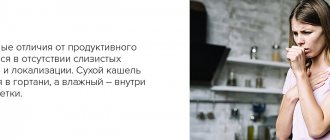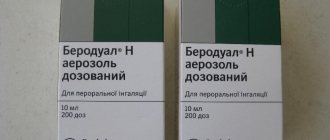Read in this article:
- Why does a dry cough appear?
- How do inhalations work on dry cough?
- When can and cannot use a nebulizer?
- What drugs are inhaled?
- Rules for the procedure
- Nebulizers for inhalation for dry cough
- How to deal with dry cough effectively and safely?
A dry cough is often a companion to ENT diseases, colds and other pathologies. Such an obsessive symptom causes discomfort and can be truly debilitating. But there are quite effective methods for treating such conditions.
Why does a dry cough appear?
First, it’s worth defining the very concept of a dry cough. Its main differences from the productive one are the absence of mucous secretions and localization. A dry cough forms in the larynx, and a wet cough forms inside the chest.
Under the influence of an inflammatory process, allergy or virus, the back wall of the larynx becomes irritated. A signal is sent to the brain that triggers the cough reflex to clear the airways. As a result, irritation of the mucous membrane of the larynx intensifies, which leads to the formation of another wave of coughing. It turns out to be a vicious circle.
When a dry cough appears, it is important to identify its cause in order to select adequate treatment. The symptom may occur when the larynx becomes inflamed or when the virus enters the lower part of the respiratory system. Sometimes in this way the body reacts to external irritants, internal pathologies, and allergens. Cough medications and treatment methods should be selected by a doctor after diagnostic procedures.
Indications and contraindications
Typically, inhalations are prescribed for obstructive bronchitis, bronchial asthma, chronic obstructive pulmonary disease, and croup syndrome.
“The nebulizer is used only to deliver a medicinal substance to the mucous membrane of the respiratory tract,” says Anastasia Shledovitz, a pediatrician at the Fantasy children’s clinic, “so there are not many main indications for its use: bronchodilators for bronchial obstruction, inhaled hormones for croup syndrome and combination drugs for bronchial obstruction. asthma. Self-prescribing these drugs can be harmful, especially for young children.”
If you have a runny nose, sinusitis, sore throat, adenoids, or redness of the throat, inhalation is not recommended.
“Often in children during the adenoid period, cough and runny nose can drag on and go beyond the normal course of ARVI, that is, last more than 10 days,” says Oleg Abramov, an otolaryngologist and head of the center for operative surgery at GMS Hospital. — Such a cough should be treated with proper drug therapy aimed at reducing snot. Inhalations with saline or hormonal agents will not have any effect in terms of cough relief.”
Inhalations are most often prescribed for a sudden cough. The course of treatment usually ranges from 1 to several days. For “residual cough” after ARVI, which occurs after sleep and when leaving a warm room into a cold one and vice versa, treatment is usually not required.
“If a child or adult has been coughing for more than three weeks due to mucus draining down the back wall of the throat,” adds Oleg Abramov, “this requires consultation with an ENT doctor to conduct an endoscopic examination and identify the cause that may lead to this.”
If there is no pathology of the nasopharynx, but a persistent cough persists, it is necessary to visit a gastroenterologist, pediatrician or therapist, in some cases an infectious disease specialist.
How do inhalations work on dry cough?
One of the most effective methods of treating dry cough is inhalation. Several decades ago, so-called “steam inhalations” were used - over a container with a special decoction.
But this method is quite dangerous because it can cause burns to the skin and respiratory tract. You should not breathe steam if there is an increase in body temperature, infectious lesions of the skin of the face or mucous membranes in the mouth.
But with the advent of special devices - nebulizers - the danger of inhalation has been reduced to zero. Such devices do not produce hot steam; the active substance is brought to an aerosol state using a compressor, a vibrating membrane or ultrasonic waves.
Inhalation procedures for dry cough provide many benefits
:
- This is the safest method of treatment, since the sprayed drug affects only the respiratory system, without causing undesirable effects on the digestive and other organs.
- Inhalations are very effective in the fight against dry cough.
- When performing the procedure from the first symptoms, the period of the disease is significantly reduced.
- Inhalation of the smallest particles of the drug facilitates the release of sputum, softens the development of the pathological process, and reduces the frequency and severity of attacks.
- With the help of a nebulizer, inhalations can be done without a visit to the clinic, at home.
- Inhalations are suitable for people of any age, the main thing is to choose the right drug and dosage.
In the nebulizer inhaler, the active substance breaks down into small particles that enter the respiratory system and act on the mucous membranes. This affects large areas of the respiratory system, including the lowest parts. The drugs successfully fight bacteria and microbes, suppress their growth, and eliminate bronchospasm.
What is a nebulizer used for?
Enlarge
A nebulizer is a modern inhaler that allows you to obtain a very fine aerosol with a drug. Everyone knows, for example, a “homemade” inhaler - boiled potatoes in a pan covered with a towel.
So, when inhaling the steam formed over potatoes, it only affects the upper parts of the respiratory tract, because the droplets are quite large in size and settle quickly. When using a nebulizer, the aerosol droplets are so small that they penetrate into the lowest parts of the lungs and there they exert their therapeutic effect.
Therefore, the main purpose of using nebulizers is to treat respiratory diseases throughout. Such diseases include bronchitis, tracheitis, laryngitis, pneumonia, sinusitis, and influenza.
When can and cannot use a nebulizer?
Nebulizer inhalations are performed for almost any ENT disease:
- bronchitis in acute, chronic, obstructive forms;
- pneumonia;
- tonsillitis;
- laryngitis;
- tracheitis;
- viral infections of the respiratory system;
- infectious diseases.
There are few contraindications for this procedure. These include a tendency to nosebleeds, respiratory or heart failure, and hypertension. Inhalations should not be performed in case of hemoptysis, individual intolerance to drugs, during or after myocardial infarction, or cerebral stroke.
Experts say
At the moment, the best way to treat acute respiratory infections is nebulizers. With their help, you can deliver the necessary medications directly to the site of inflammation - to the bronchi, trachea. It is recommended to start doing inhalations with a nebulizer at a temperature and the first signs of acute respiratory infections - coughing, runny nose, sneezing.
Nebulizers are especially effective in children: their bronchi have a small lumen and, when inflamed, quickly become clogged with the resulting sputum.
Therefore, the answer to the question: is it possible to do inhalation with a nebulizer in children at high temperatures (for example, 38 degrees or more) is definitely positive. The effect is observed literally within the first minutes after inhalation: sputum begins to disappear, a wet cough appears, the condition improves, and after a while the temperature begins to decrease.
In this case, medications administered through a nebulizer are used in such low dosages that they do not have any systemic effect on the human body.
Is it possible to do inhalations with a nebulizer at a fever? Can! Inhalations with this device at a temperature can be used not only for acute respiratory infections, but also for other acute and chronic lung diseases in adults and children, for example, pneumonia, exacerbations of chronic bronchitis, cystic fibrosis. In all cases, there is a reduction in the duration of the temperature period, a rapid improvement in well-being, accelerated recovery, and a reduced need for medication.
What drugs are inhaled?
To combat dry cough, several groups of inhalation solutions are used:
- Salt;
- Saline solution;
- Compositions with bronchodilators;
- Expectorants;
- Antiseptic drugs and antibiotics.
Saline and alkaline solutions are considered the safest but most effective means. The substances they contain help moisturize the mucous membrane, soften the cough, and make the mucus more liquid so that it comes out more easily during a cough. For this purpose, soda solutions are mainly used.
Inhalations with salt solutions are carried out no more than 5 times a day. The duration of each procedure is 5-10 minutes; about 4 ml of solution is poured into the nebulizer. Inhalation of such substances is not contraindicated for children of any age and pregnant women.
Saline solution of sodium chloride (table salt solution) is sold by pharmacies in ready-made form. For inhalation, this product is used in pure form or used for mixing with medications. Saline solution has an antiseptic effect, reduces the degree of tissue swelling, and fights microbes. For inhalation you will need 2-4 ml of solution.
Bronchodilators are prescribed to block the inflammatory process, relieve swelling, expand the lumen of the bronchi, and accelerate the release of sputum. Such drugs include Nebutamol, Ventolin, Berotek, Berodual.
Expectorants are necessary for difficult mucus removal and unproductive cough. They are characterized by an anti-inflammatory effect, liquefying the mucous substrate, facilitating its release. Drugs of this type are Mucolvan, Ambrobene, Ambroxol, ACC, Lazolvan. They are used exclusively as prescribed by a doctor, who determines the dosage and frequency of inhalation. To prepare the composition for the nebulizer, you will need saline solution.
For coughs caused by bacteria, inhalations with Dioxycin, Gentamicin, Furacilin, Miramistin and other antibiotics are performed. Self-medication is unacceptable here; you must strictly follow medical recommendations.
How to and how not to be treated with a nebulizer
What is a nebulizer?
This is a device that appeared on the market relatively recently; it serves to cleanse the lungs and treat various diseases associated with the respiratory system.
Creates a fine aerosol from a liquid (very small droplets suspended in the air). The person then inhales it through a tube or mask. What does the name "nebulizer" mean?
The term "nebulizer" comes from the Latin word nebula - fog, cloud.
Does a “healthy” person need a nebulizer?
In many cases - yes! After all, it helps cleanse the respiratory system.
Many seemingly healthy residents of cities and towns are forced to “cleanse themselves” for three or four minutes every morning—clear their throats in the bathroom or—excuse me—blow their nose. And all this is precisely because, figuratively speaking, our airways are clogged due to poor ecology. Moreover, this should be done not only by those who lead a sedentary lifestyle. People who lead a healthy lifestyle sometimes suffer from poor ecology and air pollution even more than those who are not used to bothering themselves with physical exercise! After all, when jogging, cycling, skiing, and in general during any active sports in the city or near the city - in “sort of fresh air” - we push gigantic volumes of not very clean air through our lungs. So, on the one hand, rapid “sports” breathing is beneficial for the lungs and heart - and on the other hand, with such breathing, we, figuratively speaking, more actively “pump” harmful substances into the lungs. Learn more about how to cleanse your lungs, including using a nebulizer.
In addition, even the healthiest person sometimes gets respiratory tract infections. Doctors have repeatedly suggested that you take antibiotics to fight a bacterial infection. In tablets or injections. As you understand, almost all antibiotics have a systemic effect on the body and cause side effects. And the higher the dose of antibiotic, the more serious the various adverse reactions. So, if you supply antibiotics through a nebulizer, then it will flow directly to its destination - into the bronchi and lungs. This means that a smaller dose of antibiotic will be required, and the side effects for the whole body will also be less. By the way, antibiotics through a nebulizer can be used not only for bronchitis and pneumonia, but also for tracheitis, otitis media, sinusitis and sinusitis. It is especially good to use this therapy for treating children, because the procedure is absolutely safe and painless, and the 5–10 that it takes, let the child watch cartoons, this is much better than nasty pills or unpleasant injections.
What medications and for what diseases can be used with a nebulizer?
Nebulizer therapy uses:
- drugs for thinning sputum and improving expectoration (acute and chronic bronchitis; pneumonia; COPD; bronchial asthma with difficulty in sputum discharge) - Ambrohexal, Ambroxol, Lazolvan, Ambrobene, Fluimucil, Acetylcysteine
- drugs that dilate the bronchi, relieve bronchospasm (COPD; bronchitis, including obstructive; bronchial asthma (endogenous, allergic); some types of pneumonia; laryngitis.) - Berodual, Ventolin, Berotek, Salbutamol, Salamol
- hormonal drugs with multifaceted effects, primarily anti-inflammatory and anti-edematous (bronchial asthma requiring maintenance therapy with corticosteroids; COPD) - Budesonit, Pulmicort, Budenit
- antiallergic drugs (hay fever, allergic rhinitis, including seasonal and/or year-round) - Cromohexal
- antibiotics for the destruction of bacteria that cause diseases and associated infections (bronchitis, tracheitis, pneumonia, catarrhal and purulent otitis, sinusitis, sinusitis) - antibiotic prescribed by a doctor + Fluimucil
- slightly alkaline and saline solutions to moisturize the mucous membranes in order to speed up the process of mucus removal: saline solution, soda-buffer solution.
We remind you that all medications, especially antibiotics, hormonal and systemic drugs, can only be used as prescribed by a doctor . Their administration using a nebulizer should also be discussed with your doctor . By the way, if you are planning to purchase or already have a nebulizer, inform your doctor about this. Although for many doctors, of course, it is easier to prescribe you pills, injections or droppers than to select nebulizer therapy, since this requires additional effort and higher qualifications.
What else do you need to know about nebulizers?
Be sure to carefully read the instructions for the device and the medicine, and strictly follow the doctor’s instructions. It should be taken into account that some medications should be diluted in saline, some in distilled water, and some should not be diluted. It is important to remember that solutions that can be used with a nebulizer are usually labeled “for inhalation”, and there is also a special ready-made form of such solutions - “nebula” packaging.
Some medications cannot be used in ultrasonic nebulizers.
You should also know that when simultaneously prescribing several types of drugs for nebulizer inhalation, it is necessary to adhere to a certain sequence of administration of the drugs. Bronchodilators should be inhaled first, followed by mucolytics. And after this, anti-inflammatory and antiseptic agents can be administered.
The medicine must be at room temperature!
To minimize the risk of side effects, rinse your mouth thoroughly with water after each inhalation of medications.
Try to keep the aerosol cloud out of your eyes.
To prevent skin irritation, your face should be washed after using the nebulizer with a mask.
How not to be treated with a nebulizer?
Please do not experiment with medications!
There is a widespread false claim on the Internet about the usefulness of using herbal decoctions and tinctures during nebulizer therapy (for example, for the prevention of acute respiratory infections). The use of essential oils, decoctions and infusions of medicinal herbs in nebulizers is unacceptable without a direct prescription from a doctor! The fact is that such liquids contain microscopic particles of plants, tannins, polysaccharides and other components, so if they get into the lungs and bronchi, acute allergic reactions, pulmonary spasms, bronchospasm, severe coughing and other troubles are possible. Essential oils can also cause damage to both the device and your lungs. It is better to use such products as part of aromatherapy (evaporate on a cushion of water through aroma lamps), or inhale through ordinary glass or steam inhalers, following the instructions for use.
If we talk about the real dangers that can result from improper use of a nebulizer, then you must remember to disinfect the nebulizer, hoses, and masks before the first and after each repeated use. Imagine what you will breathe through a nebulizer if mold grows in the unwashed and undried nebulizer or the remains of the medicine disintegrate into unknown components. Therefore, what is possible according to the instructions - we boil, what is not - we wash and disinfect, for example, with chlorhexidine, then dry it. It is best for each family member to use their own set of accessories (mask, mouthpiece), since they are inexpensive. We must not forget about timely change of filters; most often they are included with the device.
And be sure to consult your doctor about possible contraindications: these may include pregnancy, some pulmonary diseases, etc.
Do not pour any herbal decoctions, tinctures, solutions containing suspended particles, oils, mineral water, etc. into the nebulizer container! Only medicine or saline solution approved by your doctor! Otherwise, you can damage the device and harm your health!
Can mineral water be used in nebulizers?
The use of mineral water in nebulizers causes a lot of controversy. The opinions of medical specialists are diametrically opposed.
The Internet is full of implausible and carbon-copy “horror stories” on this topic. Moreover, the persistence with which such strange stories are spread on various forums is quite surprising.
At first glance, there is nothing dangerous in mineral water. We swim in the sea, breathe sea air, and sea water is much more saturated with salts than ordinary mineral water. But let’s still agree that until real research on this topic appears, we will refrain from drinking mineral water for inhalation through a nebulizer!
The composition of mineral water is extremely unstable, it is unsterile. Moreover, mineral water is often counterfeited. Therefore, if your doctor still prescribed mineral water for inhalation, you should only buy it at a pharmacy and check that it has a neutral or slightly alkaline reaction.
What advantages does a nebulizer have over traditional inhalers?
use of drugs in minimal effective doses. Reducing the doses of drugs entering the body is especially important for potent and hormonal drugs; a smaller dose means fewer side effects. continuous supply of small doses of medication during the session, in contrast to a single, but loading dose in inhaler sprays, is much more effective. allows, in contrast to metered-dose aerosol inhalers, to administer pure medications to all respiratory organs (nose, bronchi, lungs), without any impurities (solvents or carrier gases), which also reduces the load on the lungs and reduces the likelihood of side effects. can be used at any age, since the patient is not required to perform any conscious actions, for example, pressing the inhaler canister while inhaling, which is especially important in young children. there is no need to take a strong breath - it is important in cases of a severe attack of bronchial asthma, as well as in bedridden patients, patients in childhood, the elderly or with developmental disabilities.
Who simply needs a nebulizer to significantly improve the quality of treatment, and in many cases, the quality of life?
- patients with chronic or often recurrent bronchopulmonary diseases (bronchial asthma, COPD, chronic bronchitis, cystic fibrosis), for the complex treatment of cough with difficult to separate sputum.
- families with a child who is susceptible to frequent colds and bronchitis
- people with occupational diseases of a bronchopulmonary nature.
To whom do we highly recommend nebulizer prevention of respiratory diseases?
- smokers, including former
- athletes
- those who need to talk often and a lot (teachers, lecturers, telephone operators) or have contact with people (at work, in transport, in public places)
- elderly people
- residents of large/industrial cities
- for lovers of healthy lifestyle, spa, cleansing procedures
Can a nebulizer be used to treat children?
If prescribed by a doctor, nebulizers can be used to treat children from a very early age. Moreover, many manufacturers have special children's models made in the form of toys (B.Well PRO-115). “Children’s” models of nebulizers are equipped with special children’s and infant masks, they are less noisy, and they have inhalation speed control (B.Well MED-125).
Can a runny nose be treated with a nebulizer?
It’s possible, some nebulizer models are even equipped with special nasal attachments (for example, B.Well PRO-110).
An important condition is that nebulizer therapy is suitable for treating runny nose only of a non-infectious nature.
Exclusive information: inhalations with saline help in the treatment of atrophic rhinitis (in approximately 70% of cases).
What is the nebulizer fraction?
A very important characteristic of any nebulizer is the indicators of the nebulizer (respirable) fraction. Despite the fact that outwardly it seems that steam is coming out of the nebulizer, you need to understand that this is not steam, but an aerosol consisting of small particles of a sprayed substance. The size of these particles directly affects which part of the respiratory tract they settle in. The smallest particles are able to penetrate as deeply as possible into the lower respiratory tract (lungs and bronchi), while larger particles will settle in the upper respiratory tract (mouth, nasopharynx, throat and trachea). The best therapeutic effect is provided by particles from 2 to 5 microns (this is the so-called nebulizer fraction). This characteristic is especially important if the nebulizer is used to treat bronchial asthma or COPD. A high content of particles of the correct size is the main difference between a high-quality nebulizer. For example, b.well nebulizers ensure that the atomized aerosol contains more than 70% particles of the correct size (about 3 microns), and this is comparable to professional, hospital models. In low-quality devices, it can be much lower than 50%, i.e., in fact, more than 50% of the medicine is simply thrown away. In this case, what is important, of course, is not so much the financial losses, but the fact that with low-quality nebulizers the effectiveness and meaning of treatment are lost.
Article by Dr. Evdokimenko © August 30, 2021 All rights reserved.
Rules for the procedure
In order for the inhalation effect for dry cough to give the desired effect, you must follow some rules:
- The procedure is performed after meals, at least 1.5 hours after physical activity;
- Do not smoke, eat or drink for at least an hour after inhalation;
- It is not advisable to smoke 1 hour before inhalation;
- For ENT diseases, inhalation is done through the mouth and nose at the same time;
- Clothing should be loose enough so as not to interfere with the breathing process;
- The nebulizer must be disinfected before use.
Inhalation is performed in a sitting position, in a calm state. After the procedure, it is advisable not to talk for 20 minutes.
Nebulizers for inhalation for dry cough
Inhalations for dry coughs are performed with various types of nebulizers. Each has its own characteristics. The most common device is a compressor
, spraying of the medicinal composition is carried out under the action of a special mechanism.
The second type is mesh inhalers
, operating on the principle of membrane vibration under the influence of ultrasound.






